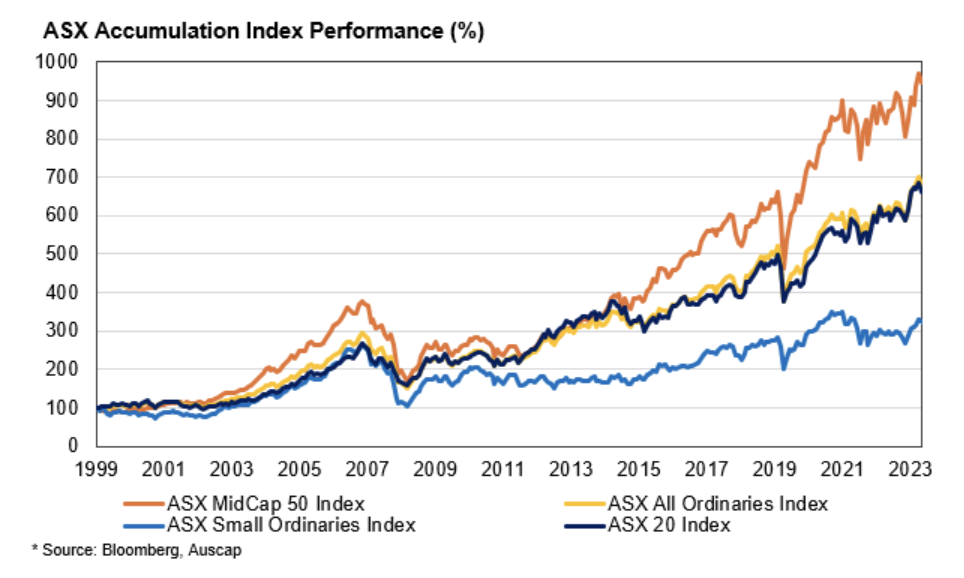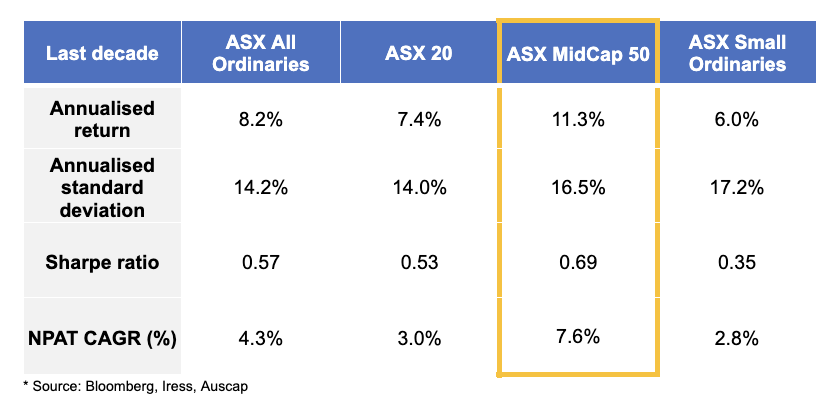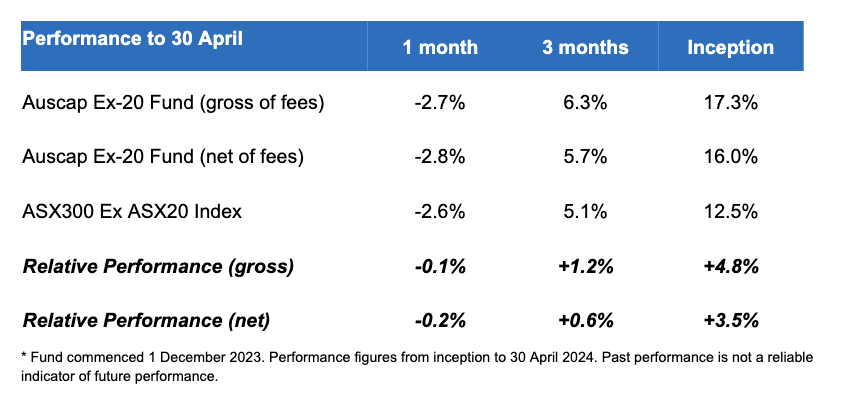The top-performing area of the ASX over the last 10 years
Over the past 10 years, this area of the market has delivered a compound annual growth rate (CAGR) in net profits of 7.6%. The annualised return of its related index has lifted 11.3% over that same time period.
Can you guess what this segment of the market is?
It's not small caps - which have delivered net profit growth of 2.7% per annum, with the benchmark lifting 6% annually over that period. It's not large caps either - with the ASX 20 delivering annualised growth of 3% and the index lifting 7.4% per annum over the last 10 years.
If you guessed mid-caps - you'd be correct... Which is why Auscap Asset Management has recently launched an Auscap Ex-20 Australian Equities Fund.
"In the Australian market, there are only a small number of funds that focus on mid-caps. Yet over almost every time horizon, Australian mid-caps have outperformed large caps, small caps and microcaps," portfolio manager Tim Carleton says.
In this wire, you'll learn why mid-caps have outperformed their peers over the long term, how Auscap is finding opportunities in this space, as well as a few examples of companies on their wishlist.
.jpg)
Why did you decide to launch the Auscap Ex-20 Australian Equities Fund?
In the Australian market, there are only a small number of funds that focus on mid-caps. Yet over almost every time horizon, Australian mid-caps have outperformed large caps, small caps and microcaps. The Auscap Ex-20 Australian Equities Fund is a predominantly mid-cap-focused fund that looks to invest in best-of-breed businesses.

What compelling evidence is there for investing outside of the ASX’s biggest stocks?
Over the last decade, the ASX MidCap50 Index has delivered earnings growth of 7.6% per annum, compared to the ASX 20 Index which has done 3.0% and the ASX Small Ordinaries Index which has done 2.8%.
Over the long run, the total return you should expect to receive is the earnings growth plus the dividend yield. So it is no surprise that over that period, the annualised return of the ASX MidCap 50 Index at 11.3% is well ahead of the ASX 20 Index at 7.4% and the ASX Small Ordinaries Index at 6%.

This should not really be a surprise. The Australian large caps have limited opportunity for organic growth over and above Australia’s economic growth because their markets are fully penetrated. Think the Australian banks, supermarkets and telcos. In the mining space, the iron ore players are dominant globally and exposed to slowing iron ore consumption in China. So we think earnings growth will continue to be modest for many of these companies.
At the other end of the market, the small companies are often either at a competitive disadvantage to their larger peers or are pre-earnings or concept stocks. Very few of these companies successfully navigate to become mid-cap companies.
Then in the middle is what we describe as the sweet spot. These are companies that are well established, often dominant in their particular category, but still have plenty of opportunities to grow market share.
So they can grow their revenues at rates above that of the market and their operating scale and efficiencies allow a lot of the incremental gross margin to drop through to growing earnings. We think Australian investors are underweight these types of companies.
Given that the Fed has just kept rates on hold, and inflation is proving to be stickier than previously thought, what’s your outlook on mid-caps over the next 12 months?
Over the short term, investors tend to focus on a broad range of factors including inflation, interest rates, geopolitics, domestic politics and market sentiment. The market often reacts to changes in these factors over the short term, which in some cases can extend to a period of several years. But it is important to recognise that while these things are observable, they are not forecastable.
We do not make economic forecasts and we certainly do not base investment decisions on economic forecasts. Over the long run, it is earnings that drive share prices.
If we invest in companies that are growing their earnings at attractive rates, and we do not overpay for these investments, then the Fund’s returns should be underpinned by the earnings growth of the portfolio. We think mid-caps are best placed to deliver strong earnings growth over time.
How do you and the team at Auscap identify winning stocks? Take us through your process in three simple steps.
We first look for high-quality businesses. These are businesses that are generating a superior return on investment. This is a marker that there is something about the business that gives it a competitive edge over its peers who earn a lower return on the same investment. If we can identify the competitive advantage then we can also work out if that edge is growing, shrinking or staying the same.
We then look at the opportunities in front of the business. We want businesses with a high return on capital that have plenty of opportunities to deploy capital at these high rates of return.
This means that the business is likely to have a long runway of earnings growth. We look for companies where we expect earnings will be materially higher in five and 10 years from where they are today, and have a high degree of confidence that the business will be able to achieve this.
Finally, we think about what we would be happy to pay for the business. This will depend upon many factors, including our view of the quality of the business, the reliability of the earnings and the rate of growth of earnings, to name a few. We want to buy into a business when it is priced at what we believe to be a fair or attractive price.
Take Nick Scali (ASX: NCK), which is a business we have owned for a long time. It has an average historic return on equity of over 50%, which is market-leading. It has opportunities to expand its store network in Australia through both the Nick Scali and Plush brands, and following its recent acquisition of what is effectively a 21 store network in England an opportunity to roll out the brand in the UK. This should lead to strong earnings growth over time for the business. And it is trading at a multiple that is well below the broader market. So it has all three attributes we look for.
What makes this fund different to the long/short fund?
The Auscap Long Short Australian Equities Fund is a high-conviction fund. As a high-conviction fund, the capital is concentrated in the highest-conviction investments. Its top ten positions are currently 57% of the Fund and the top 20 positions represent about 83% of the capital base. It can invest across the spectrum of Australian equities. Position sizes are based on how attractive we find the opportunity. It is completely sector-unaware so there will be times when it behaves very differently to the market. This suits some investors and not others.
By comparison, the Auscap Ex-20 Australian Equities Fund has a defined universe. It is focused on stocks from the 21st largest in the Australian market down to the 300th. So it will not buy into businesses that are in the ASX20, which are what most would classify as large-cap companies. Many Australian investors are already invested in these companies and do not need us to double up on that exposure.
The main difference between the two funds is the fact that the Auscap Ex-20 Australian Equities Fund is sector-aware. So its sector exposures over time will look very similar to the sector exposures of the S&P/ASX300 excluding the S&P/ASX20 Index. That means we expect the Ex-20 Fund will have volatility similar to its benchmark Index.
What we are doing is isolating Auscap’s stock-picking ability, choosing the best companies in each of the sectors of the market, and letting that be the driver of performance. The objective of the Ex-20 Fund is to deliver relatively consistent outperformance over time.
The fund has been running for around 4-5 months now – are you fully invested?
We were close to fully invested within a few days of the Fund launching in December. Valuations looked attractive to us. We disclose the top 20 investments each month in our newsletter and we would encourage readers who are interested in the Fund to have a look at the exposures.
Are there any companies on your wishlist?
There are a few companies that are in the portfolio that are small exposures for one reason or another that we would like to increase the Fund’s exposure to at the right time.
One company that falls into that bucket is Reece (ASX: REH). It’s a great company with a strong track record of return on invested capital. It is in the process of developing a significant business in the US in addition to its market-leading offering in Australia. We have spent time in the US looking at their offering and we have confidence in how they are progressing there.
We hold a position in both Auscap funds but the current valuation holds us back from owning more. So if we got a pullback in the market or the individual stock that gave us an opportunity at a more attractive valuation we would be looking to add to our position.
There aren’t that many businesses that we don’t own at all that we would like to own. There are a small number of companies we like but the market valuation is a long way above what we would be happy to pay to buy into them. The list of businesses we like to own doesn’t change very much over time.
How has the fund performed so far?
The Fund has had a strong start. It is up 16% net of fees for the first 5 months. Its benchmark index is up around 12.5% over the same time horizon. So it is delivering some good alpha which is great for the early investors in that Fund.

Find out more about Auscap here.

4 topics
2 stocks mentioned
1 fund mentioned
2 contributors mentioned

